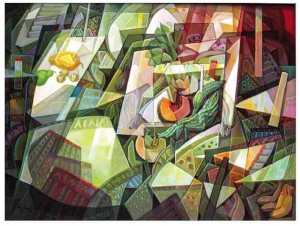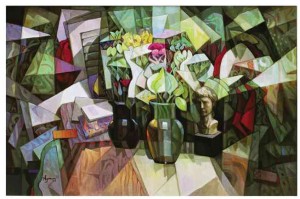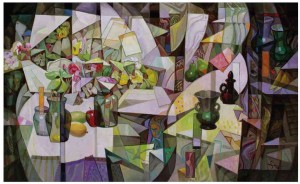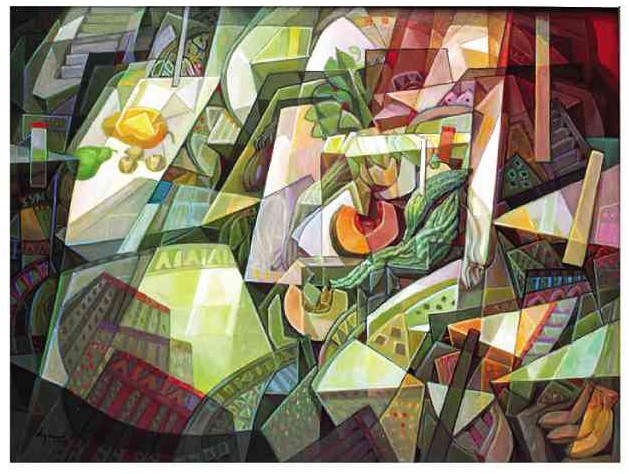
Strange how one epithet of a word, uttered in confusion, can grow to have a life of its own. Ironic, too, that the perpetrator of such mischief could be the most influential critic of the time.
One such word was the “cube”—and one such critic was someone named Louis Vauxcelles. He first heard the word from Matisse, the reputed rival of Picasso, who told the critic, “Braque has just sent in[to the 1908 Salon d’Automne] a painting made of little cubes.” Matisse was referring to a painting that depicted simplified, boxy shapes of houses with deconstructed perspective. Braque and Picasso had worked so closely that the latter had described their relationship, thus: “We were like mountaineers roped together.”
Thence in an exhibition of Cubist works, the critic disparagingly described them as “bizarreries cubiques.” And thus the term Cubism came to be.
Cubism became the first abstract style, characterized by its rejection of perspective and its emphasis on a multiple perspective.
The Cubists wanted an art that recognized the changing world, now reflected in the advancement of photography and cinematography. The invention of the telephone, the motor car and the airplane destroyed the boundaries of communication and travel.

The impact of Cubism was felt by artists in Germany, Holland, Italy, England, America and Russia. In Italy, an outgrowth of Cubism was called Futurism, which celebrated speed, violence and the mechanization of the modern world. In America, the Cubist practitioners depicted the New York landscape of soaring skyscrapers, speeding automobiles and wide-spanning iron bridges.
Alas, after a little more than a decade, Cubism quickly fell into disrepute. An art historian, Paul Johnson, wrote, “Being the first form of fashion art, Cubism itself was soon abandoned by all its abler practitioners, who moved on to new styles. By 1930 there was no artist so out-of-date as a Cubist. It had however a curious persistence in the works of countless artists of the 1920s, 1930s and 1940s, who wished to paint in a figurative manner but who also wished to identify themselves as modern.” Indeed, while Marcel Duchamp was referring to a painting, he might as well be alluding to an art movement, when he said that “after 40 or 50 years, a picture dies, because its freshness disappears. I think a painting dies after a few years like the man who painted it. Afterwards it’s called the history of art.”
In the Philippines, one such artist was Vicente Manansala, whose name became most closely associated with the term “Transparent Cubism.” Like the original Cubists, Manansala favored the still life. Thus he fragmented the forms of fruits and vegetables, kitchen and domestic scenes, and later, human figures such as beggars, candle vendors, sabungeros, and Mother and Child.
By all admission, the Cubist works of Sofronio Y. Mendoza, now better known by the initials SYM, emerged in the local art scene even much later than those of Manansala. For these works to emerge in the 21st century even compounds the problem of assessing his works. To be sure, SYM had taken the grave risk of being denounced as “derrier-garde” (the French word derrier meaning behind) as opposed to being avant-garde (avant, meaning advance or vanguard, literally fore-guard). The hallmarks of avant-garde art are experimentation and innovation. Against this background of prejudice, what is SYM to do?
Poundian exhortation
“Make it new!” proclaimed Ezra Pound, a pioneer of modernism in poetry. The same of course could be applied to any of the arts, whether literature, music, cinema or painting. After all, an idiom such as Impressionism (in which SYM excelled and first made his name) or Abstraction has been pronounced dead, but as often resurrected. To a large extent, the fact that the contemporary audience now has been exposed to the Cubist idea of multiple perspective, is a great advantage for SYM, who no longer has to contend with the shock that greeted the works of the original Cubists.

Indeed, SYM can help elucidate, in visual terms, what may already have eluded the present-day viewers. In the words of John Golden who wrote a book on the history of Cubism, the pictorial innovations of Picasso and Braque consisted of: “the construction of a painting in terms of a linear grid or framework, the fusion of objects with their surroundings, the combination of several views of an object in a single image, and of abstract and representational elements in the same picture.” These are the data stored in the identity of SYM as a Cubist.
Undoubtedly, SYM’s works are all visually intelligible and guided by purely formal concerns. One recalls the praise received by Braque from another Cubist painter, Jean Metzinger: “Whether he paints a face, a fruit, the entire image pulses incessantly. The painting is no longer an inert grouping of concurrent masses.” It is a praise one can steal for the works of SYM.
One can’t help but break into smile, if not outright hilarity, at the sight of one SYM work titled “Transparent Tilapia.” It is hardly a veiled reference to Manansala’s style of Cubism, indeed it is an acknowledgment of the master’s own exploration of the idiom. And just as Manansala’s affection for figuration prevented him from fragmenting his images into indecipherable forms, the same is true for SYM. His lush and profuse celebration of fish, fruits, vegetables and objects are an abundant massing of a tropical feast and scenery: bananas, watermelons, eggplants, stringbeans, mangoes, mangosteen, papayas and pineapples, jostling side by side jars, vases and bottles, and in one instance, a statue of David, in an exhilarating complex and geometrical composition. They are deployed in layers of planes, subdivided by glinting light, but always the treatment is the pursuit of abstraction, as clearly manifest in the titles that directly admit to color dominance, interaction, harmony, movement and rhythm, with affinities to Kandinsky’s “compositions” and “experiments.”
An expert in building up his forms, SYM revels in the use of geometry which defines each of the paintings in the insistent and progressive multiplicity of squares and rectangles, circles (dots) and triangles, all conjoined in a dazzling and dynamic design. There is all assurance that SYM exercised perfect control in manipulating the pictorial space reaching into a deep recession.
And as for colors, forget the dingy greys and muddy browns of Picasso and Braque. SYM, grounded in the radiant light of his country, harmoniously blends the brilliant colors of the spectrum, almost ritualistically blending alizarin reds with peaches and oranges, sky blues with chartreuse and viridian, lemon and chrome yellows shifting with purples and pinks and magentas. Elation in colors will never leave a Filipino Cubist.
Cid Reyes is the author of coffeetable books on National Artists Arturo Luz, Bencab, J. Elizalde Navarro and Napoleon Abueva. He received a Best in Criticism award from the Art Association of the Philippines (AAP).









































